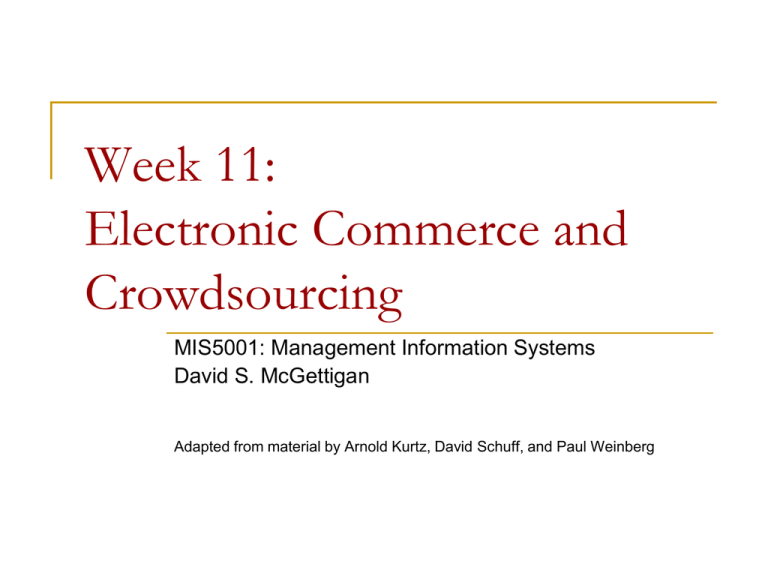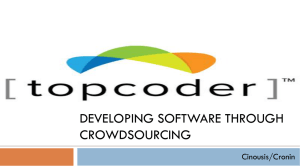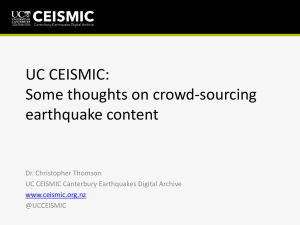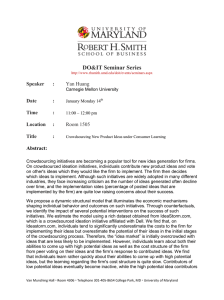
Week 11:
Electronic Commerce and
Crowdsourcing
MIS5001: Management Information Systems
David S. McGettigan
Adapted from material by Arnold Kurtz, David Schuff, and Paul Weinberg
Agenda
Prior Lecture Recap
Electronic Commerce
Crowdsourcing
Next Week
2
Prior Lecture Recap
Prior Lecture Recap
Role of the CIO
Most Time Spent
Collaborating with CXOs
Making Strategic Decisions
Working on Strategic Business Planning
Obstacles to Success
Overwhelming Project Backlog and Requests
Ability to Execute Remains a Top Concern
Focus on Cost Cutting
Opportunities
Using IT to Enable / Standardize Business Processes
Measuring Success and Proving Business Value
A Modern CIO
Deputies Run Operations
Focus on Strategy and Execution
Source: www.cio.com: “State of the CIO”
4
eBusiness
I think the Internet is uniquely suited to this free market idea:
that everyone on the Internet that exchanges the traffic back
and forth, big or small, we all need each other.
Pete Ashdown, Utah Geek Dinner Speech, 08-22-06
founder and CEO of Utah 's first independent and oldest Internet service provider, XMission
Internet: Features and Business Value
Copyright 2006
Prentice Hall
All rights reserved
Management Information Systems
Managing the Digital Firm
(Ninth Edition)
6
Internet: Creation of New Markets
Copyright 2004
The McGraw-Hill Companies, Inc.
All rights reserved
Management Information Systems
for the Information Age
(Fourth Edition)
7
Business to Consumer (B2C)
E-tailer - an Internet retail site.
Pure plays - Internet retailers without a physical store.
Clicks–and-mortar retailers - both an Internet presence
and one or more physical stores.
M-commerce - describes e-commerce conducted over a
wireless device such as a cell phone or PDA.
Copyright 2004
The McGraw-Hill Companies, Inc.
All rights reserved
Management Information Systems
for the Information Age
(Fourth Edition)
8
B2C - Key Success Factors
Product Type
Marketing Mix
Search Engines
Online and Offline Ads
Execution
Commodity
Digital
Customer Service
Monitor Competition and
Threats
Cyveilance Corp
9
B2C – Competition
Ford Motor Example
10
B2C – Threats
Ford Motor Example
11
B2C – Search Engines
Ford Motor Example
12
B2C – Search Engines
Best Buy Example
13
B2B – Corporate Purchasing
Direct materials - used in production in a
manufacturing company or for retail sales.
Indirect materials - necessary for running a
corporation, but do not relate to the primary
business activities.
Electronic data interchange (EDI) - computer-tocomputer transfer of transaction information.
Copyright 2004
The McGraw-Hill Companies, Inc.
All rights reserved
Management Information Systems
for the Information Age
(Fourth Edition)
14
B2B – Indirect Materials
www.staples.com
www.boise.com
What is the difference in these business models?
15
B2B - Commerce
B2B marketplaces Internet-based services that
bring together buyers and
sellers.
Reverse auction - the
process in which a buyer
posts its interest in buying a
certain quantity of items,
and sellers compete for the
business by submitting
successively lower bids until
there is only one seller left.
Copyright 2004
The McGraw-Hill Companies, Inc.
All rights reserved
Management Information Systems
for the Information Age
(Fourth Edition)
16
C2C – Classic Example
17
C2B – Lesser Known … More Academic
18
The Role Of E-Government
E-Government describes the
application of ecommerce
technologies in
governmental
agencies.
Copyright 2004
The McGraw-Hill Companies, Inc.
All rights reserved
Management Information Systems
for the Information Age
(Fourth Edition)
19
Learning from the Mistakes of Others
Furniture.com closes
doors, lays off most of
staff
Pets.com latest highprofile dot-com disaster
Food.com lays off half its
staff; execs step down
WebMD to lay off 1,100
workers
The worst crime against working
people is a company which fails
to operate at a profit.
Samuel Gompers, 1908
20
Significant Successes?
The following was the status of well
known firms in 2003. Where are they
now?
Expedia.com – 13% of
traditional travel agencies
closed down
Dell – pricing below
competition with an 8% margin
Lending Tree – growing at
70% per year
WebMD – expanded model to
include claim processing
Napster – success or failure?
Source: Business Week: May 12, 2003
21
Crowdsourcing
Crowdsourcing is channeling the experts desire to solve
a problem and then freely sharing the answer with
everyone.
Henk van Ess (writer / reporter)
22
Crowdsourcing
Crowdsourcing is the act
of outsourcing tasks,
traditionally performed
by an employee or
contractor, to a large
group of people or
community (a crowd),
through an open call
Benefits:
Problems can be explored at comparatively little cost, and often very
quickly.
Payment is by results or even omitted
The organization can tap a wider range of talent than might be present in its
own organization.
By listening to the crowd, organizations gain first-hand insight on their
customers' desires.
The community may feel a brand-building kinship with the crowdsourcing
organization.
Source: Wikipedia and YourEnccore.com
23
Crowdsourcing
Drawbacks:
Added costs to bring a project to an acceptable conclusion.
Likelihood of failure:
lack of monetary motivation, too few participants, lower quality of
work, lack of personal interest in the project, global language
barriers, or difficulty managing a large-scale, crowdsourced
project.
Difficulties maintaining a working relationship with
crowdsourced workers throughout the duration of a project.
Susceptibility to faulty results caused by targeted, malicious
work efforts.
Examples:
Entertainment (web videos), scientific (problem solving),
academic (wikipedia)
Source: Wikipedia and YourEnccore.com
24
TopCoder
Describe the basic business model of
TopCoder.
Compare and contrast the TopCoder
software development process to traditional
software development methods. When would
you use which?
How can other firms apply design principles
of the TopCoder process to other domains?
25
Next Week
Google





